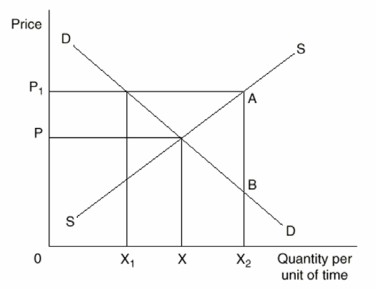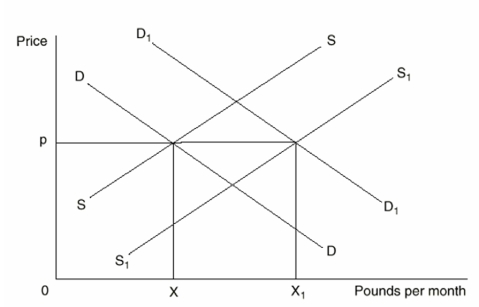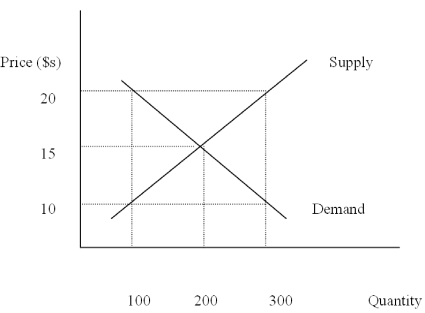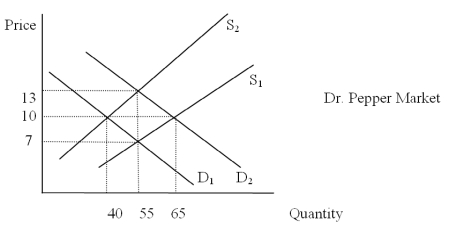A) Quantity demanded to demand to rise
B) Demand to fall
C) Quantity supplied to fall
D) Supply to rise
E) None of the above
Correct Answer

verified
Correct Answer
verified
Multiple Choice
The Following Questions Refer to the graph below.  -At price P1 there is a
-At price P1 there is a
A) Surplus of X1X2
B) Shortage of X1X2
C) Surplus of XX2
D) Surplus of AB
E) Shortage of X1X
Correct Answer

verified
Correct Answer
verified
Multiple Choice
After establishing the Republic of China in 1949,Mao's Communist Party patterned the Chinese economy after
A) Japan
B) Taiwan
C) The USSR
D) The United States
E) Europe
Correct Answer

verified
Correct Answer
verified
True/False
Demand is the quantity of a product per time period that buyers will buy at the prevailing price,other things equal
Correct Answer

verified
Correct Answer
verified
Multiple Choice
In the market economy,markets serve the function of
A) Coordinating resource use decisions made by individual owners of resources
B) Bringing about resource allocation changes desired by resource owners
C) Determining prices
D) All of the above
E) Both (a) and (b)
Correct Answer

verified
Correct Answer
verified
True/False
In the long run,an increase in the demand for a good will result in an increase in supply of the good in a market economy
Correct Answer

verified
Correct Answer
verified
Multiple Choice
Which of the following is least consistent with the pure market economy?
A) An established legal system that arbitrates contract disputes
B) An individual accepting a job for $1 per hour
C) The institution of private property rights
D) The existence of a minimum wage
E) Private property rights
Correct Answer

verified
Correct Answer
verified
Multiple Choice
The Following Questions Refer to the graph below.  -The demand curve and supply curve for beef are DD and SS.The demand curve shifts to D1D1 and a price ceiling is placed on beef at price p.The result will be
-The demand curve and supply curve for beef are DD and SS.The demand curve shifts to D1D1 and a price ceiling is placed on beef at price p.The result will be
A) A surplus equal to X1X
B) A shift in the supply curve to S1S1
C) An increase in the quantity placed on the market to X1
D) Both (b) and (c) above
E) A shortage equal to X1X
Correct Answer

verified
Correct Answer
verified
Multiple Choice
The Following Questions Refer to the graph below.  -Which of the following could lead to a price of $20 in the market?
-Which of the following could lead to a price of $20 in the market?
A) An increase in demand
B) A decrease in supply
C) A decrease in demand
D) An increase in supply
E) An increase in both supply and demand
Correct Answer

verified
Correct Answer
verified
Multiple Choice
An increase in the price of flashlights will have what effect on the equilibrium price and quantity of batteries?
A) Price will increase,quantity will decrease
B) Price will increase,quantity will increase
C) Price will decrease,quantity will decrease
D) Price will decrease,quantity will increase
E) The new equilibrium price and quantity can not be determined
Correct Answer

verified
Correct Answer
verified
Multiple Choice
The Following Questions Refer to the graph below.  -The demand curve and supply curve for beef are DD and SS.Which of the following could cause supply to shift to S1S1?
-The demand curve and supply curve for beef are DD and SS.Which of the following could cause supply to shift to S1S1?
A) An increase in the cost of production
B) A decrease in the cost of production
C) An increase in the price of a substitute in production
D) An increase in income
E) All of the above
Correct Answer

verified
Correct Answer
verified
Multiple Choice
A change in the quantity demanded
A) Results whenever one of the "other things equal" underlying the demand curve changes
B) Results when the price of the product increases or decreases
C) Means a shift in the position of the demand curve
D) Means movement along a given demand curve
E) Is both (b) and (d)
Correct Answer

verified
Correct Answer
verified
True/False
If you buy more of a good as a result of an increase in income,the good is known as a consumer good
Correct Answer

verified
Correct Answer
verified
True/False
An increase in the price of gas will cause an increase in the supply of gas since it will be more profitable to sell
Correct Answer

verified
Correct Answer
verified
Multiple Choice
A situation in which the demand for a product is decreasing while the price is simultaneously increasing can be explained by
A) A decrease in supply
B) An increase in supply
C) Unchanged supply
D) All of the above
E) None of the above
Correct Answer

verified
Correct Answer
verified
True/False
In the pure command economy,most resource use decisions are made by government
Correct Answer

verified
Correct Answer
verified
True/False
Surpluses tend to drive competitive prices downward toward equilibrium,and shortages tend to drive competitive prices upward toward equilibrium
Correct Answer

verified
Correct Answer
verified
Multiple Choice
The Following Questions Refer to the graph below.  -If the market starts in equilibrium with D1 and S1,price and quantity are
-If the market starts in equilibrium with D1 and S1,price and quantity are
A) 13 and 55
B) 10 and 40
C) 10 and 65
D) 7 and 55
E) 10 and 55
Correct Answer

verified
Correct Answer
verified
Multiple Choice
China can be best described as a
A) Market economy
B) Mixed economy
C) Transitional economy
D) Competitive economy
E) Monopoly economy
Correct Answer

verified
Correct Answer
verified
Multiple Choice
The economy of the People's Republic of China operated as a command economy
A) From 1917 until 1949
B) from 1949 until 1978
C) Since 1990
D) From 1949 until 1962
E) Which started China's transition to a market economy
Correct Answer

verified
Correct Answer
verified
Showing 101 - 120 of 122
Related Exams